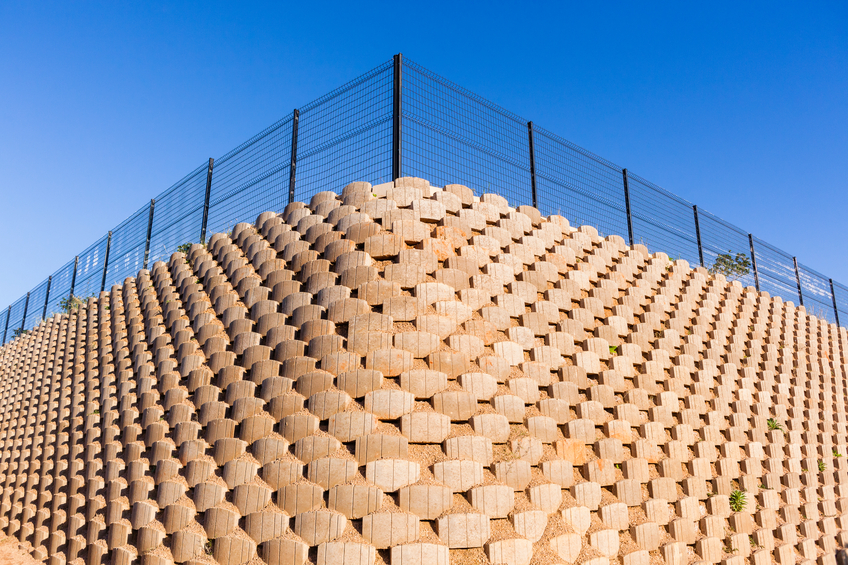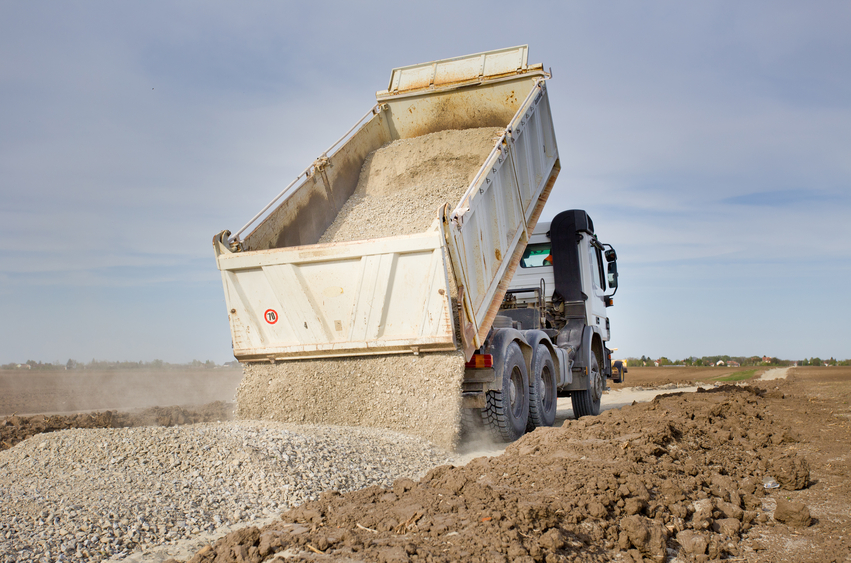Soil Mechanics15 PDH Discount Package 2
Courses in this Package
An Introduction to Geotextiles for Soil Wall Reinforcement (G02-009)
An Introduction to Identification and Classification of Soil and Rock (G03-001)
An Introduction to Slope Stability Analysis (G02-005)
An Introduction to Slope Stability and Protection (C06-006)
An Introduction to Soil Grouting (C02-017)

This online engineering PDH course provides an introduction to material specifications and design methods to employ when designing geotextile reinforced soil walls.
Geotextiles have been utilized in the construction of reinforced soil walls since the early 1970's. Geotextile sheets are used to wrap compacted soil in layers producing a stable composite structure. Geotextile-reinforced soil walls somewhat resemble the popular sandbag walls which have been used for some decades. However, geotextile-reinforced walls can be constructed to significant height because of the geotextile's higher strength and a simple mechanized construction procedure.
Soil, especially granular, is relatively strong under compressive stresses. When reinforced, significant tensile stresses can be carried by the reinforcement resulting in a composite structure, which possesses wider margins of strength. This extra strength means that steeper slopes can be built.
This 2 PDH online course is intended for civil and geotechnical engineers and other design and construction professionals wanting to learn how to design soil walls with geotextile reinforcement.
This PE continuing education course is intended to provide you with the following specific knowledge and skills:
- Learning about the advantages of geotextile reinforced walls
- Understanding the disadvantages of geotextile reinforced walls
- Knowing the recommended properties of retained soils in geotextile reinforced walls
- Understanding how backfill soil has a direct effect on the external stability of the wall
- Understanding the design method recommended for retaining walls reinforced with geotextiles developed by the U.S. Forest Service
- Learning how to calculate the lateral earth pressure at any depth below the top of the wall
- Learning how to calculate lateral pressures from live loads for a point load acting on the surface of the backfill
- Understanding why free-draining granular materials should be used as retained soil
In this professional engineering CEU course, you need to review the course document titled, "An Introduction to Geotextiles for Soil Wall Reinforcement".
Upon successful completion of the quiz, print your Certificate of Completion instantly. (Note: if you are paying by check or money order, you will be able to print it after we receive your payment.) For your convenience, we will also email it to you. Please note that you can log in to your account at any time to access and print your Certificate of Completion.

This online engineering PDH course will introduce you to the principles and practices of identification and classification of soil and rock. Identification and classification are the essential first steps in soil mechanics and engineering, and engineering of foundations for structures such as buildings, dams and bridges. This course will provide you with an understanding of the soil and rock materials in order to proceed with the engineering analysis and design of a specific project.
This 3 PDH online course is intended for geotechnical, environmental and structural engineers, design professionals, and construction personnel who are interested in gaining an understanding of the basic principles of soil and rock identification and classification.
This PE continuing education course is intended to provide you with the following specific knowledge and skills:
- Learning the importance of the geologic origin and mode of occurrence of soils
- Learning about residual and organic sedimentary soils.
- Learning the different types of aeolian soils and their properties
- Learning the properties of glacial soil deposits
- Learning how to identify marine, colluvial and pyroclastic soils
- Learning the definitions and terminology associated with soil fractions and components
- Learning about the Unified Soil Classification System and how to use it with visual and laboratory classification methods
- Learning about the Standard Penetration Test and Atterberg Plasticity Limits
- Learning the properties of igneous, metamorphic and sedimentary rock
- Learning the principles and terminology of rock weathering and discontinuities
In this professional engineering CEU course, you need to review the course document titled, "An Introduction to Identification and Classification of Soil and Rock".
Upon successful completion of the quiz, print your Certificate of Completion instantly. (Note: if you are paying by check or money order, you will be able to print it after we receive your payment.) For your convenience, we will also email it to you. Please note that you can log in to your account at any time to access and print your Certificate of Completion.

This online engineering PDH course presents the characteristics and critical aspects of the stability of excavation slopes; methods of designing slopes, including field observations and experience, slope stability charts, and detailed analyses; factors of safety; and methods of stabilizing slopes and slides. Slope stability analyses are useful in sands, silts, and normally consolidated and over-consolidated clays, but care must be taken to select the correct strength parameter. The emphasis in this publication is on simple, routine procedures. It does not deal with specialized problems, such as the stability of excavated slopes during earthquakes.
Excavation slope instability may result from: 1) failure to control seepage forces in and at the toe of the slope, 2) too steep slopes for the shear strength of the material being excavated, and 3) insufficient shear strength of subgrade soils. Slope instability may occur suddenly, as the slope is being excavated, or after the slope has been standing for some time.
This 2 PDH online course is intended for civil engineers, structural engineers, geotechnical engineers, geologists and other design and construction professionals seeking an introduction to methods and techniques for addressing slope stability issues in earth structures and earthwork.
This PE continuing education course is intended to provide you with the following specific knowledge and skills:
- Learning about slopes of cohesive and cohesionless soils on firm underlying strata
- Learning about problems encountered with soft underlying strata
- Learning about special problems encountered with stiff-fissured clays and shales
- Understanding how to address issues encountered in loess soils
- Knowing how to apply slope stability charts to address many common stability issues
- Knowing how to apply the Method of Moments and the Method of Slices
- Learning how to use the Simplified Wedge Method to address slope stability issues
In this professional engineering CEU course, you need to review the course document titled, ""An Introduction to Slope Stability Analysis".
Upon successful completion of the quiz, print your Certificate of Completion instantly. (Note: if you are paying by check or money order, you will be able to print it after we receive your payment.) For your convenience, we will also email it to you. Please note that you can log in to your account at any time to access and print your Certificate of Completion.

This online engineering PDH course presents methods of analyzing stability of natural slopes and safety of embankments. Diagrams are included for stability analysis, and procedures for slope stabilization are discussed. Methods of analysis are also discussed, including the limit equilibrium method, limit analysis and finite element method. Translational failure analysis and recommended safety factors are provided. Earthquake loading and the effects of soil parameters and groundwater on stability are presented. You will learn about slope stabilization techniques including regrading, seepage and groundwater control, as well as retaining structures.
This 6 PDH online course is intended for civil and geotechnical engineers and other infrastructure design and construction professionals who want to learn about the basic technology, design guidelines and materials and equipment used for analysis of slope stability and protection methods.
This PE continuing education course is intended to provide you with the following specific knowledge and skills:
- Learning about the modes of slope failure
- Understanding the effects of soil or rock type on slope failures
- Learning how to analyze slopes for failure risk
- Understanding the Simplified Bishop Method for slope analysis
- Knowing the slope stability charts, including rotational failure in cohesive soils
- Learning about translational failure analysis methods
- Understanding the effects of soil parameters and groundwater on slope stability
- Learning about stability problems in special materials
- Learning about stabilization structures such as piers and retaining walls
In this professional engineering CEU course, you need to review the course document titled, "An Introduction to Slope Stabilty and Protection".
Upon successful completion of the quiz, print your Certificate of Completion instantly. (Note: if you are paying by check or money order, you will be able to print it after we receive your payment.) For your convenience, we will also email it to you. Please note that you can log in to your account at any time to access and print your Certificate of Completion.

This online engineering PDH course presents the common types of soil grouting materials including Portland-cement, clay, chemical, and asphaltic grouts that are now in use. It also presents grout properties and the various grouting applications on construction projects. This course also discusses the types of admixtures and fillers used and their effects on the grout.
Grouting is a widely used method for strengthening and sealing rock, soil and concrete. The possibilities for sealing structures are of great importance from both an economic and environmental point of view. To improve the technique for grouting with cement-based material, it is necessary to examine the properties of the grout mixture used. No one grout is suitable for every situation as the unique properties of each specific grout make it desirable under certain circumstances. In planning a grouting program for particular conditions, the engineer needs knowledge of the various types of grouts and their properties.
This 2 PDH online course is intended for civil, geotechnical and structural engineers as well as construction professionals who are interested in gaining a better understanding of soil grouting technology. In particular, it provides engineers with an understanding of how grouting is used to strengthen and seal rock formations, soil and concrete.
This PE continuing education course is intended to provide you with the following specific knowledge and skills:
- Learn about the characteristics and applications of the primary soil grouts: Portland-cement, clay, asphalt and chemical.
- Learn about how to improve the performance of grouts with admixtures such as accelerators and lubricants.
- Learn about polymerized grouts including acrylamide, resorcinol-formaldehyde, calcium acrylate and epoxy resin.
- Learn about grouting procedures such as curtain, blanket or area, contact, and mine/cavity grouting.
- Learn about the importance of pressure testing and washing in grouting.
- Learn how groundwater can affect grouting operations.
In this professional engineering CEU course, you need to review the course document titled: "An Introduction to Soil Grouting".
Upon successful completion of the quiz, print your Certificate of Completion instantly. (Note: if you are paying by check or money order, you will be able to print it after we receive your payment.) For your convenience, we will also email it to you. Please note that you can log in to your account at any time to access and print your Certificate of Completion.